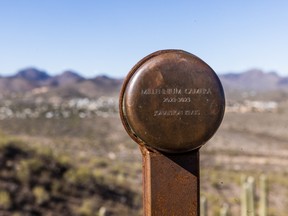Article content material
In case you’ve ever taken a long-exposure or slow-shutter {photograph} – of the evening sky, say, or to show a metropolis avenue right into a streak of tail lights – you’ll have some inkling of what thinker Jonathan Keats is as much as within the desert outdoors Tucson, Ariz.
His publicity is just a bit longer, his shutter slightly slower. As a substitute of a minute, or an hour, he plans to take a single {photograph} over the following thousand years.
Article content material
The Millennium Digital camera, because the experimental thinker and analysis affiliate on the College of Arizona’s Faculty of Tremendous Arts calls his creation, is an easy, low-tech system. It needs to be, if it’s going to final for the following ten centuries.
A metal pole topped by a small copper cylinder, the Millennium Digital camera faces the desert panorama and a neighbourhood known as Star Move on the outskirts of Tucson. One finish of the cylinder includes a tiny pinhole that may enable a smidgeon of sunshine to enter. The opposite seems to be like a Methuselan tombstone, embossed with its creator’s title and the dates “2023 – 3023.”
Contained in the cylinder is a light-sensitive floor lined in lots of skinny layers of an oil paint pigment known as rose madder. The thought is that, over the centuries, the sunshine will trigger the rose madder to fade, progressively create a picture.
Beneficial from Editorial
-
Here is how Earth nearly ended up with a 60-hour day
-

Norwegian man looking for to abolish time
The digicam and accompanying signage are subsequent to a bench together with a preferred mountaineering path, inviting folks to cease and ponder this experiment in what’s often known as deep time.
Article content material
“Deep time” refers to scales of time which are huge and geological, as distinct from the way in which people understand timescales on the order of days or years. Although the time period was coined by creator John McPhee in a 1981 guide about geology, the notion has lengthy held a fascination with philosophers. In 1788, a mere 236 years in the past, scientist John Playfair remarked after taking a look at rock strata that “the thoughts appeared to develop giddy by wanting up to now into the abyss of time.”

“Most individuals have a reasonably bleak outlook on what lies forward,” Keats says in a press launch from the College. “It’s straightforward to think about that folks in 1,000 years might see a model of Tucson that’s far worse than what we see in the present day, however the truth that we are able to think about it isn’t a nasty factor. It’s really a great factor, as a result of if we are able to think about that, then we are able to additionally think about what else may occur, and due to this fact it would encourage us to take motion to form our future.”
Keats is absolutely conscious that his experiment may not run its course. It’s troublesome to plan contingencies for an artefact meant to final so long as the Bayeux tapestry or the earliest recognized copy of Beowulf. However he clearly relishes the concept of what such {a photograph} may reveal.
Article content material
“Let’s take a extremely dramatic case the place all of the housing is eliminated 500 years sooner or later,” he says. “What is going to occur then is the mountains will probably be clear and sharp and opaque, and the housing will probably be ghostly. All change will probably be superimposed on one picture that may be reconstructed layer by layer when it comes to interpretation of the ultimate picture.”
He additionally factors out that the philosophy behind his venture is one among impartial remark. “Certainly not is the digicam making a press release about growth – about how we must always construct town or not going ahead,” he says. “It’s set there to ask us to ask questions and to enter into dialog and invite the angle of future generations within the sense that they’re in our minds.”
The Millennium Digital camera isn’t even Keats’ first foray into deep time. In 2010 he created the Century Digital camera, printed in Good Journal and supposed to be lower out, folded right into a field and left to climate for 100 years. Keats promised {that a} particular version of the journal could be printed in 2110 with readers’ submissions of their ensuing images.
Keats has plans to arrange extra Millennium Cameras in Chongqing, China; Griffith Park in Los Angeles; the Austrian Alps; and the Santa Rita Experimental Vary in Arizona, the place scientists have already been taking repeated images of the identical places repeatedly for greater than a century.
He may also need to take into account setting one up on the Science Museum in London, England. That’s the placement of a prototype of the Clock of the Lengthy Now, a deep-time timepiece designed to tick every year, advance its century hand as soon as each hundred years, and chime on the millennium. When it strikes AD 3000, it could sign that Keats’ {photograph} could be nearly prepared for viewing.
Our web site is the place for the most recent breaking information, unique scoops, longreads and provocative commentary. Please bookmark nationalpost.com and join our newsletters right here.
Share this text in your social community




